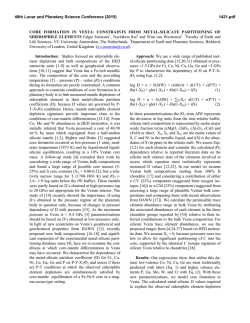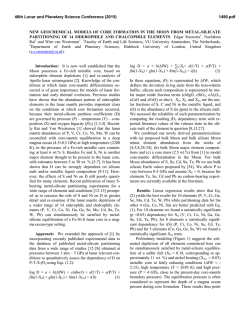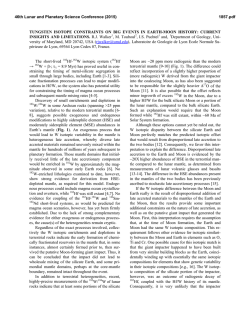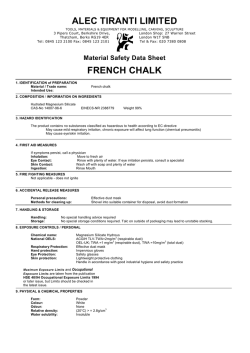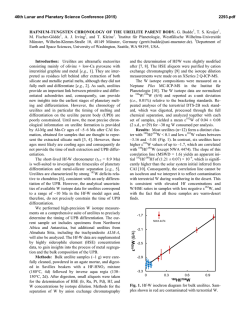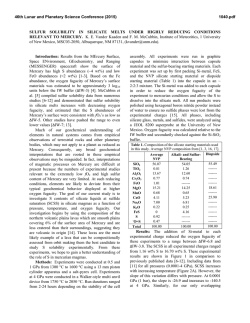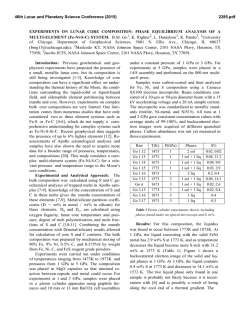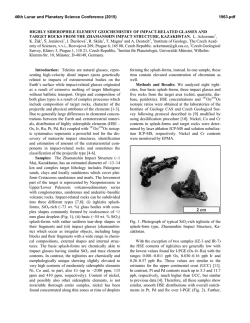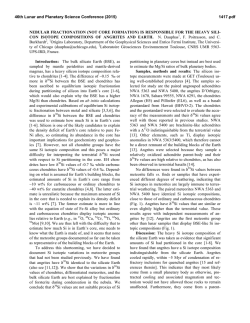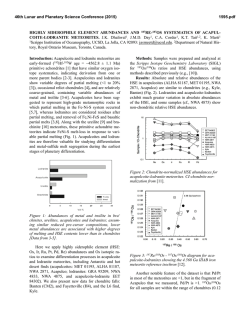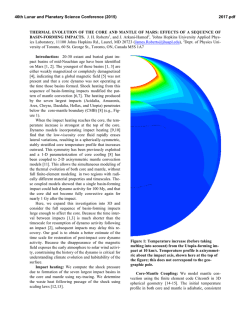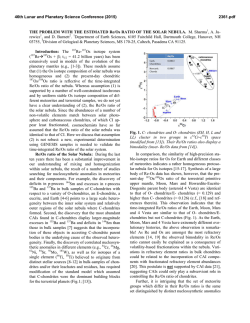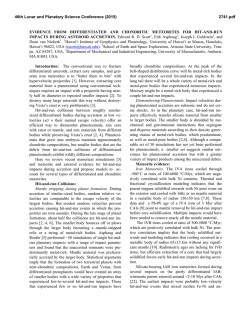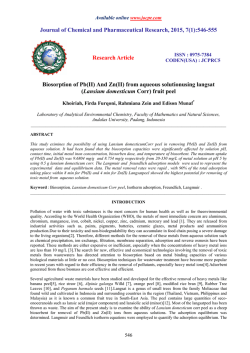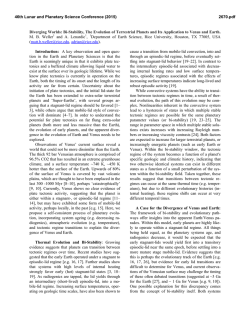
origin of volatiles in earth: indigenous versus - USRA
46th Lunar and Planetary Science Conference (2015) 2650.pdf ORIGIN OF VOLATILES IN EARTH: INDIGENOUS VERSUS EXOGENOUS SOURCES BASED ON HIGHLY SIDEROPHILE, VOLATILE SIDEROPHILE, AND LIGHT VOLATILE ELEMENTS. K. Righter1, L. Danielson2, K. M. Pando2, N. Marin3, K. Nickodem4, 1NASA-JSC, Houston, TX 77058; 2Jacobs Technology, NASA-JSC, Houston, TX; 3SESE, Arizona State University, Tempe, AZ; 4Department of Geography, Syracuse University, Syracuse, NY. Introduction: Origin of Earth’s volatiles has traditionally been ascribed to late accretion of material after major differentiation events – chondrites, comets, ice or other exogenous sources [1]. A competing theory is that the Earth accreted its volatiles as it was built, thus water and other building blocks were present early and during differentiation and core formation (indigenous) [2]. Here we discuss geochemical evidence from three groups of elements that suggests Earth’s volatiles were acquired during accretion and did not require additional sources after differentiation. Experimental: Differentiation of Earth into core and mantle controlled the distribution of many elements. Experimental studies at high pressure and temperature have focused on many of these elements and in particular have examined their partitioning between metallic and silicate liquids, or D(metal/silicate). Our group has studied highly siderophile elements (HSE), volatile siderophile elements (VSE), and the light elements that are also siderophile – S, C, N and H; studies were carried out between 1 and 20 GPa and 1500 to 2400 °C in piston cylinder and multi-anvil apparatuses (e.g., [3-6]). We have combined our results with previous studies on these elements [7-12] to evaluate how D(metal/silicate) is affected at the conditions of an early deep magma ocean. For In, As, Sb, and Ge we have focused on the effect of Si alloyed with Fe liquid, because Si is thought to be a significant light element in the Earth’s core. For example, D(In) exhibits a small chemical dependence on Si content of the metal, while D(Sb) exhibits a much larger effect (Fig. 1). Other elements such as Bi, Cd, and HSE have very little data so far and the focus has been on understanding more fundamental factors such as temperature. For example, D(Bi) shows lowering by ~100x between 1500 and 2000 °C at 1 GPa (Fig. 2), while D(Pd) shows more modest lowering across the same PT range (Fig. 3). HSE: High P and T conditions have been studied [5-9], as has the effect of S [10]. HSE in Earth’s mantle cannot be reconciled with a purely FeNi core (i.e. Ds remain too high), but light elements such as S and C cause dramatic lowering of D(metal/silicate). An FeNi-S-C-Si core may cause lowering of D(Pt, Pd, Ir, Ru and Au) metal/silicate to values required by equilibrium core formation. In this case, a late veneer Figure 1: Effect of Si (in metallic alloy) on D(In) and D(Sb) metal/silicate. All experiments at 1600 ºC and 1 GPa. Figure 2: Effect of Temperature on D(Bi) metal/silicate. All experiments at 1 GPa. Dashed line is based on chondritic and mantle Bi values [24]. Nubers next to datapoints indicate MgO content of silicate melt. would not be required, and mantle HSE would be established by a deep magma ocean as for the moderately siderophile elements Ni, Co, Mo and W (e.g., [13]). VSE: High P and T conditions, as well as S- and Cbearing Fe alloys, have been studied [3,4,11,12]. This group of elements encompass a large range of valence from 1+ (Cu, In,) to 2+ (Zn, Cd, Ge) to 3+ (Ga, As, Sb, Bi) to 4+ (Sn), and thus can be sensitive to fO2. Consideration of all P-T-fO2-X effects shows that all VSE can be explained in Earth’s mantle by a combination of 46th Lunar and Planetary Science Conference (2015) Figure 3: Effect of temperature on D(Pd) metal/silicate. All experiments at 1 GPa. Solid symbols are MgO capsules and open symbols are graphite capsules. volatile depleted building blocks and metal-silicate equilibrium during accretion. Light volatiles – H, N, C, and S: All four of these light volatile elements are also siderophile, with D(metal/silicate) > 1. Hydrogen is the least well understood, but studies at 7 GPa indicate moderately siderophile behavior [14]. Nitrogen is moderately siderophile with a D(metal/silicate) near 10 to 20 in early Earth conditions [15]. Carbon is strongly siderophile with 100 < D(metal/silicate) < 1000 at conditions of early Earth, although more experimentation is desirable at >10 GPa [16]. Finally, S is well understood across a wide range of P-T-fO2-X conditions [17]. The S content of the primitive mantle can be explained by an early deep magma ocean on Earth. In summary, S and N contents of Earth’s PUM can be reconciled with an early magma ocean scenario. Earth’s PUM contents of C and H, however, are higher than predicted by experimental D(metal/silicate) (Fig. 4) and require an additional source such as ingassing from a thick H2O-CO2rich atmosphere once core formation ceased [16]. Implications: Concentrations of many volatile elements in Earth’s mantle can be explained by equilibrium partitioning between core and mantle during accretion and growth. Several elements may require additional interaction with the atmosphere or ingassing (C and perhaps H). Therefore Earth’s volatiles may have largely been acquired during accretion (indigenous) rather than later after differentiation had ceased (exogenous). This is also consistent with some recent studies of H and N in inner solar system bodies [18, 19], Ca, Ru and Mo isotopes [20, 21], and noble gases [22]. 2650.pdf Figure 4: C, H2O, N, and S concentrations in the bulk silicate Earth, from [23,24], shown as either black rectangle or circle. Calculated values (open circles) are based on work of [16] for carbon, [25] for H2O, [15] for nitrogen, and [17] sulfur. Bulk Earth values are from [23] and [26] and are as follows: C = 530 ppm, N = 1.68 ppm, H2O = 2700 ppm, and S = 2 wt%. References: [1] Delsemme, A.H. (1998) Planetary and Space Science 47, 125-131. [2] Abe, Y. et al. (2000) In Origin of the Earth and Moon, 413-433. [3] Nickodem, K. et al. (2012) 43rd LPS, #2295. [4] Marin, N. et al. (2013) 44th LPS, #1848. [5] Righter, K., et al. (2008) Nature Geoscience 1, 321-323. [6] Righter, K. et al. (2015) MAPS, in press. [7] Brenan, J. and McDonough, W.F. (2009) Nature Geoscience 2, 798-801. [8] Mann, U. et al. (2012) GCA 84, 593-613. [9] Cottrell, E. and Walker, D. (2006) GCA 70, 15651580. 10] Laurenz, V. et al. (2013) GCA 108, 172-183. [11] Ballhaus, C. et al. (2012) EPSL 362, 237-245. [12] Mann, U. et al. (2009) GCA 73, 7360-7386. [13] Righter, K. (2011) EPSL 304, 158-167. [14] Okuchi, T. (1997) Science 278, 1781-1784. [15] Roskosz, M. et al. (2013) GCA 121, 15-28. [16] Chi, H. et al. (2014) GCA 139, 447-471. [17] Boujibar, A. et al. (2014) EPSL 391, 42-54. [18] Sarafian, A. et al. (2014) Science 346, 623-626. [19] Altwegg, K. et al. (2014) Science, 1261952. [20] Simon, J.I. et al. (2010) EPSL 289, 457-466. [21] Dauphas, N. et al. (2014) EPSL 407, 96-108. [22] Tucker, J. and Mukhopadhyay, S. (2014) EPSL 393, 254-265. [23] Marty, B. (2012) EPSL 313, 56-66. [24] Palme, H. and O’Neill, H.St.C. (2013) Treatise on Geochemistry, 2nd edition. [25] Kuramoto, K. and Matsui, T. (1996) JGR Planets 101, 14909-14932. [26] Eggler, D. and Lorand, J.-P. (1993) GCA 57, 2213-2222.
© Copyright 2026
